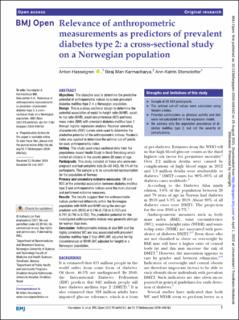| dc.contributor.author | Hasselgren, Anton | |
| dc.contributor.author | Karmacharya, Biraj Man | |
| dc.contributor.author | Stensdotter, Ann-Katrin | |
| dc.date.accessioned | 2022-04-07T09:17:23Z | |
| dc.date.available | 2022-04-07T09:17:23Z | |
| dc.date.created | 2021-09-15T13:51:08Z | |
| dc.date.issued | 2021 | |
| dc.identifier.citation | BMJ Open. 2021, 11 (8), 1-7. | en_US |
| dc.identifier.issn | 2044-6055 | |
| dc.identifier.uri | https://hdl.handle.net/11250/2990446 | |
| dc.description.abstract | Objectives The objective was to determine the predictive potential of anthropometric indices to screen prevalent diabetes mellitus type 2 in a Norwegian population. Design This is a cross-sectional design to determine the potential association of waist-to-height ratio (WHtR), waist-to-hip ratio (WHR), waist circumference (WC) and body mass index (BMI) with prevalent diabetes mellitus type 2 through logistic regression analysis. Receiver operating characteristic (ROC) curves were used to determine the predictive potential of the anthropometric indices. Youden’s index was applied to determine the optimal cut-off points for each anthropometric index. Setting This study used cross-sectional data from the populations-based Health Study in Nord-Trøndelag which invited all citizens in the county above 20 years of age. Participants This study included all those who were non-pregnant and had complete data (N=50 042), 98.5% of the participants. The sample is to be considered representative for the population of Norway. Primary and secondary outcome measures OR and ROC of the potential association between diabetes mellitus type 2 and anthropometric indices were the main planned and performed outcome measures. Results The results suggest that the anthropometric indices performed differently within the Norwegian population with WHR and WHtR being the stronger predictor with (ROC) of 0.746 (0.735 to 0.757) and 0.741 (0.730 to 0.752). The predictive potential for the investigated anthropometric indices was generally stronger for women than men. Conclusion Anthropometric indices of size BMI and the highly correlated WC are less associated with prevalent diabetes mellitus type 2 than WHR (WC adjusted for hip circumference) or WHtR (WC adjusted for height) in a Norwegian population. | en_US |
| dc.language.iso | eng | en_US |
| dc.publisher | BMJ Publishing Group | en_US |
| dc.rights | Navngivelse-Ikkekommersiell 4.0 Internasjonal | * |
| dc.rights.uri | http://creativecommons.org/licenses/by-nc/4.0/deed.no | * |
| dc.title | Relevance of anthropometric measurements as predictors of prevalent diabetes type 2: A cross-sectional study on a Norwegian population | en_US |
| dc.type | Peer reviewed | en_US |
| dc.type | Journal article | en_US |
| dc.description.version | publishedVersion | en_US |
| dc.source.pagenumber | 1-7 | en_US |
| dc.source.volume | 11 | en_US |
| dc.source.journal | BMJ Open | en_US |
| dc.source.issue | 8 | en_US |
| dc.identifier.doi | 10.1136/bmjopen-2020-046162 | |
| dc.identifier.cristin | 1934574 | |
| cristin.ispublished | true | |
| cristin.fulltext | original | |
| cristin.qualitycode | 1 | |

